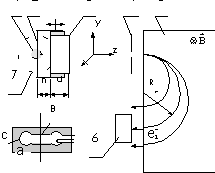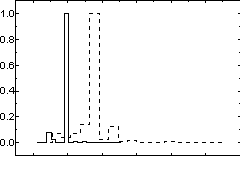Design of a bunch phase distribution monitor with
resolution in fs-time range operating on the principle of rf-sweeping
of secondary electrons produced in a result of a Mller scattering
in a wire target is considered. To minimize chromatic aberration
the scattered electrons are separated in narrow energy band in
kV-range by spectrometer installed after the monitor rf-deflector
so that the planes of the electron analysis in rf-phase and energy
one are orthogonal to each other. Apparatus function of the monitor
primary converter in a form of a time - energy distribution of
the electrons passing through the hole of collimator installed
in front of the rf-deflector is defined with a Monte Carlo calculation
on a scheme of individual collisions.
Method for bunch phase distribution measurement based
on rf-sweeping of secondary electrons produced in a result of
Mller scattering was proposed by one of the authors of the paper
25 years ago [1]. Option of this method was defined by fundamental
properties of chosen physical process allowing to fulfilled the
measurements with resolution in fs-time range. During these years
the author has carried out researches for creation the monitor
realizing this method which, to some extent, had been restricted
by possibilities of computers and the level of development of
physical models for transport calculation of electrons in keV-energy
range those time. In connection with interest to this measurements,
increased extremely at present, in the paper this monitor is described.
New precise calculations of electron transport in a carbon target
for real geometry of the monitor have been accomplished, and some
results are presented here below.
The monitor is schematically shown in Fig.1. Delta-electrons
produced in a result of a primary beam (1) interaction with carbon
fibre (2) of 8 m diameter are selected at scattering angle of
90 in a view of a narrow beam by means of a collimator (with hole
of 1 mm diameter) installed in front of rf-resonator (3) on a
distance 5 mm from the target (2). The phase distribution of selected
delta-electrons is coherently transformed into transverse one
through rf-modulation in the rf-deflector (3). The rf-deflector
is a resonator of a slit-hole type the cross section of which
is shown in Fig.1,a where the length from point A to B along the
resonator surface is a quarter of wave length. Resonance frequency
does not depend on h-distance, and the last is determined by the
electron transit phase. To minimize chromatic aberration the delta-electrons
are also separated in narrow energy band by spectrometer (5) installed
so that the planes of the electron analysis in rf-phase and energy
are orthogonal to each other. Radius of main electron trajectory
in the spectrometer is 100 mm. The target (2) together with the
rf-deflector (3) is moved in the beam (1) for a time of measurements.

Monitors are similar to the above mentioned one,
but operating on the low energy secondary electrons, have been
successfully realized already. As to this monitor there are two
main questions which have to be solved, namely: temporal apparatus
function of the primary converter of the monitor and its efficiency.
Apparatus function of the primary converter is determined
as a flight time of electrons from the start plane which is perpendicular
to the primary beam axis and tangent the target to the finish
one being perpendicular to the delta-electron beam axis and tangent
the target too, i.e. the time involves the flight time of both
beams. The function was calculated with Monte Carlo simulation
using some results from [2,3]. The apparatus function in a view
of the time distribution of the delta-electrons with energies
of 10 and 50 keV within +_50 eV and at the condition of their
passing through the collimator hole are shown in Fig.2.

FWHM of these distribution for the electrons with energies of 50 keV and 10 keV are 6.5 fs and 13.6 fs, respectively. It should be noted that these results have been determined for the beam radius of 1 mm, uniform beam current distribution and at installation of the target in the beam current maximum. The electron energy of the primary beam is 10 MeV.
Probability of escaping of the delta-electron captured
by the collimator hole per an electron of the primary beam have
been determined at the same conditions as for the time dispersion
calculations. For the delta-electron energies equaled to 1, 3,
10 and 50 keV the probabilities are 1.210-7, 5.210-8,
2.210-8 and 4.510-9, respectively. Hence,
having an electron beam with 10 13 or more population for a time
of measurements one can measure the bunch phase distribution with
the above mentioned resolution (Fig.2).
This work was supported by grant (No.96-0218364)
of the Russian Fund for Fundamental Researches.
[1] A.M.Tron, "Method of Bunch Phase Distribution", Author's certificate of invanture, No.484814, with priority of March 1972.
[2] M.E.Riley, C.J.MacCallum, F.Biggs, "Theoretical Electron - Atom Elastic Cross Section", Atomic Data and Nuclear Data Tables, 15, p.443 (1975).
[3] F.Salvat, J.Parellada, "A Simple Monte Carlo Calculation of Kilovolt Electron Transport", J.Phys.D: Appl.Phys., 17, p.185 (1984).